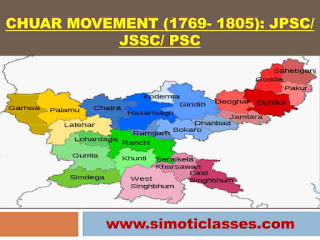Revolts/ Movement:
Chero Revolt (1770-71):
In the year 1770-71, the Chero ruler Chitrajit Rai of Palamu and his Dewan Jaynath Singh organized a rebellion against the British fighting on behalf of Gopal Rai, the claimant to the throne of Palamu, which is known as 'Chero Rebellion'. In fact, it was a battle to capture the throne of Palamu.
Eventually, the British Captain Jacob Camac was successful in defeating the Cheros' rebels and capturing Palamu. On July 1, 1771, Gopal Rai was declared the king of the Palamu.
Bhogta Revolt (1771):
In fact, the Bhogta rebellion was a supplementary event of the Chero rebellion (1770-71). Jainath Singh, the Diwan (Prime Minister) of Raja Chitrajit Rai of Palamu was a bountiful chieftain. The British used to talk directly to Jainath Singh only.
On January 9, 1771, Jainath Singh received a letter from Patna Council through his messenger Ghulam Hussain Khan, in which order was given to hand over the Palamu Fort to the company peacefully. From here the Bhogta rebellion started. It was fought together with the Cheros. Jainath Singh was ready to leave Palamu Fort, but with some conditions.
Since the Company was intent on capturing the Palamu Fort, therefore, the British refused to accept conditions laid by Jainath Singh, calling them unreasonable. The fight has started. Both Bhogta and Cheros fought the British together, but Bhogta Sardar Jayanath Singh was defeated and fled to Sarguja and the British declared Gopal Rai as the king of Palamu.
Chero Movement/ Andolan (1800-1818):
The Chero tribe of Palamu revolted under the leadership of Bhukhan Singh in 1800 against the high tax collection and re-acquisition of sub-dependent pattas. In suppressing it, the British resorted to deceit and cunning. As a result of this rebellion, in 1809, the British government formed the Zamindari Police Force to maintain peace and order in Chotanagpur.
1814: Under the guise of action of Palamu pargana, the British captured it and handed over the responsibility of governance to Raja Ghanshyam Singh of Bhardev. In 1817, they revolted against this conspiracy of the British by ensuing tribal cooperation, but this too was suppressed. This rebellion was suppressed by Colonel Jones.
Previous Page:Bhumij Revolt (1832-33): JPSC/ JSSC/ PSC
Next Page:Ho Movement (1820-21): JPSC/ JSSC/ PSC








































